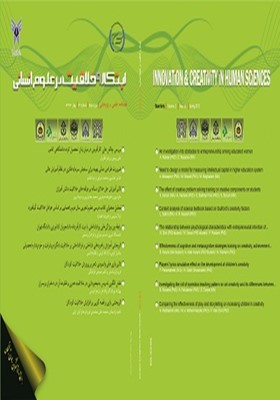تحلیل محتوای کتاب درسی علوم تجربی سال دوم راهنمایی بر اساس عوامل خلاقیت گیلفورد
محورهای موضوعی : خلاقیت و نوآوری از جنبه‏های روان‏شناختی، علوم شناختی، علوم تربیتی و آموزشی (خلاقیت شناسی روان‏شناختی، خلاقیت شناسی پرورشی)
1 - نویسنده مسئول
2 - نویسنده
کلید واژه: تحلیل محتوا, خلاقیت, محتوا, دوره راهنمایی, کتاب درسی علوم تجربی, عوامل خلاقیت گیلفورد,
چکیده مقاله :
زمینه : حل مسأله و خلاقیت از ممتازترین توانایی های شناختی انسان است. کشورهای دنیا پرورش قوه خلاقیت شاگردان را ارزشمندترین هدف تربیتی به شمار میآورند. روش: روش تحقیق در این پژوهش توصیفی-پیمایشی از نوع تحلیل محتوا و کاربردی می باشد. جامعه آماری این پژوهش شامل محتوای کتاب درسی علوم تجربی دوم راهنمایی در سال تحصیلی 90- 1389 می باشد. حجم نمونه برابر با حجم جامعه آماری انتخاب گردیده است. ابزار این تحقیق فرم تحلیل محتوای محقق ساخته با توجه به الگوی عوامل خلاقیت گیلفورد می باشد. برای تحلیل محتوای کتاب درسی علوم تجربی دوم راهنمایی از یک طرح کد گذاری استفاده شده است. این کار در سه مرحله انجام شده است. در مرحله اول محتوای کتاب به چهار قسمت (متن، تکالیف و فعالیت ها، تصاویر و جداول) تقسیم شده؛ در مرحله دوم کلیه واحدها در تمامی قسمت ها با طبقه مورد نظر، از نظر شاخص های خلاقیت گیلفورد مطابقت داده شده و در جداول مربوطه ثبت شده؛ و در مرحله سوم واحدهایی که در سطح بالای عوامل خلاقیت گیلفورد قرار داشتند شناسایی و شمارش شده اند. روایی ابزار تحقیق بر اساس نظرات متخصصان تعلیم و تربیت قابل قبول بود و پایایی بر اساس فرمول هولستی مورد محاسبه قرار گرفته است (مقدار آن 93/0). داده های حاصل با استفاده از آمار توصیفی ( شامل فراوانی و درصد) مورد تجزیه وتحلیل قرار گرفته است . هدف: این مقاله به بررسی کتاب علوم تجربی ازنظرمحتوای آموزشی مناسب برای رشد خلاقیت پرداخته است. یافته ها: کتاب درسی علوم تجربی دوم راهنمایی تأکید بیش از حد به سطح حافظه شناختی و تفکر همگرا دارد و به تفکر واگرا و تفکر ارزشیاب در حد ضعیفی توجه نموده است. نتیجه گیری: درمحتوای کتاب درسی علوم تجربی دوم راهنمایی بین سطوح گوناگون خلاقیت گیلفورد تعادل مناسبی وجود ندارد و بایستی در این زمینه تمهیداتی اندیشیده شود.
Background: The present research entitled “content analysis of science textbook based on Guilford’s creativity factors". Analyzing the content of science textbooks could have an important role to enhance the content and pupils' creativity levels respectably. Method: The research method is descriptive and a content analysis type. The statistical society of this research included a second guidance year experimental science textbook in the academic year of 1389-90. The sample volume is equal with statistical society. Instrument of this research is a researcher made form of content analysis depending on Guilford’s creativity factors. To analyze the content of second guidance year experimental science textbook a coding schema has been used. This work was conducted in three stages, in the first stage, the book was divided into four parts (text, assignments and activity, images and tables). In the second stage all units in all parts of the desired class were matched with Guilford’s creativity parameters and were recorded in related tables. In the third stage, those units which were in the high level of Guilford’s creativity factors were identified and counted. Validity of research tools based on education expert opinion was notable and reliability tools based on Holsty formula and 93% was calculated. Data using descriptive statistics (including frequency and percentage) were analyzed. Purpose: The most important issue in educating the creative children is making use of appropriate teaching contents. Result (s): The results showed that the second guidance year experimental science textbook focus too much on the level of cognitive memory and convergent thinking and has poor attention on divergent and evaluation thinking. Conclusion: The results indicates the point that in content of second guidance year experimental science textbook, There is no appropriate balance between different levels of Guilford’s creativity.


